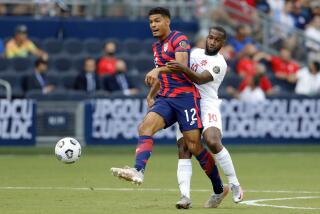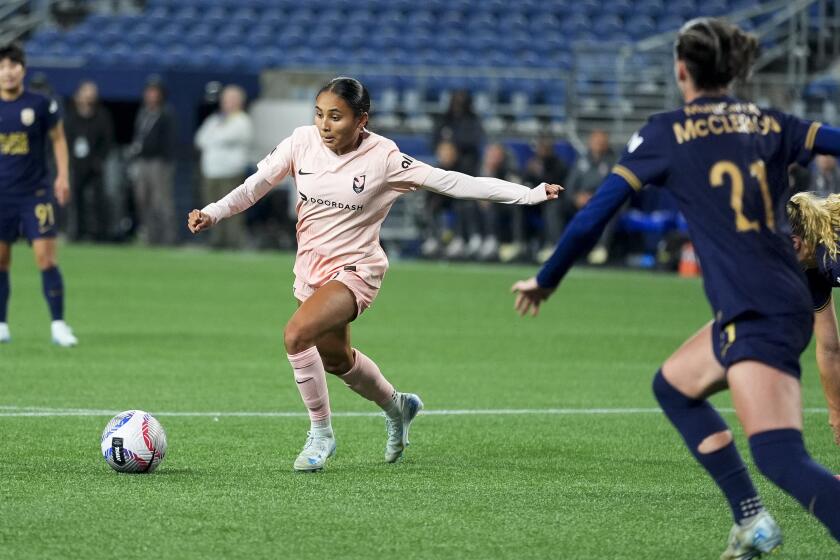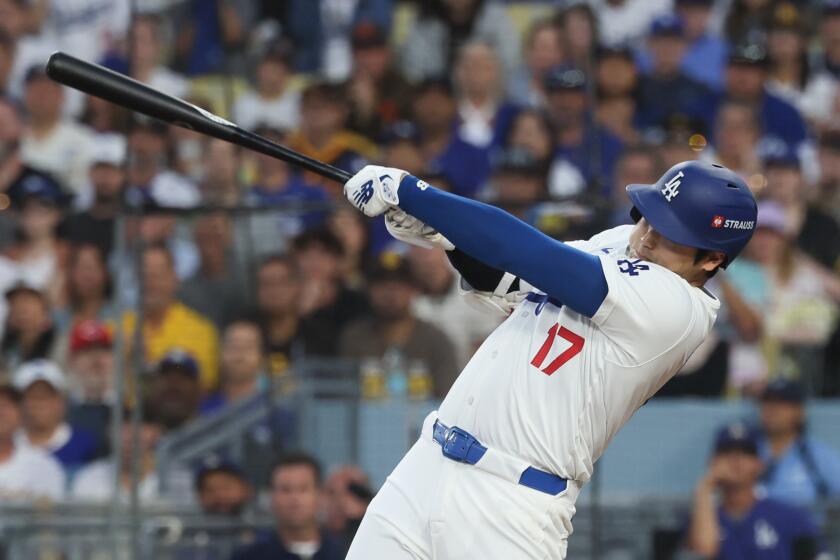Surprising Draw Leaves U.S. in a Fix : World Cup: Little goes as expected. United States winds up in a group with Colombia, Romania and Switzerland.
- Share via
LAS VEGAS — The outcome of Sunday’s World Cup draw should put to rest any lingering doubts that a small group of international soccer officials place teams into groups at whim.
If officials were to fix the draw, this would not be the way they would do it. The inexplicable caprice known as the draw--secrets held within blue plastic balls--has seriously undermined the U.S. team’s chances of advancing past the first round and has dumped three teams with huge followings into the same group.
The resulting schedule places the United States with Colombia, one of the most dynamic teams in the tournament, and throws three powerful eggs into the same basket--Italy, Ireland and Mexico. At the same time, the defending champion, Germany, is grouped with one dangerous team, Spain, and two of the tournament’s weakest, Bolivia and South Korea.
It is impossible to please everyone, and this draw was no exception. Venue officials in Boston, who had all but been told they could expect Ireland, were frantic. Mexico, which had been sure it would be based in Dallas, not only was sent to play two games in humid Washington, D.C., but also was grouped with Italy, Ireland and Norway. World Cup ’94 Chairman Alan Rothenberg called it the “Group of Death.”
For the U.S. team, it could have been worse, but not by much. The first team drawn into its group was Colombia, which is ranked 21st in the world but was one of the strongest teams in South America during World Cup qualifying. Colombia defeated Argentina, 5-0, in a qualifying match that forced the 1986 World Cup champion to qualify for the World Cup as a wild card.
The next round of the draw yielded Romania, ranked 13th. Switzerland, ranked 12th, was drawn last. The U.S. team, ranked 22nd, is the lowest ranked in its group and the lowest ranked of the six seeded teams.
“Believe me, if there was a fix, no one would fix Colombia in the U.S. group,” Rothenberg said.
Sunday’s televised draw show at the Las Vegas Convention Center set the schedule for next summer’s World Cup, which will be held in nine U.S. cities from June 17-July 17. The opening game of the 24-team tournament will pit Germany against Bolivia at Chicago.
The first U.S. team game will be against Switzerland on June 18 at Pontiac, Mich.
The United States will play Colombia at the Rose Bowl on June 22 and Romania at the Rose Bowl on June 26.
Calculated strictly by FIFA rankings, Italy’s Group E is by far the most difficult, Group B with Brazil, Russia, Cameroon and Sweden the second strongest and Group A, with the U.S. team, the third strongest.
The groups put to rest the notion that the draw would come out in such a way that it would speed the U.S. team on its way to the second round.
“They are very difficult countries to play,” U.S. Coach Bora Milutinovic said. “But I am very sure that we will make it (to the second round.)”
Rothenberg said he was pleased in general with the draw. But World Cup officials were not pleased with the impact the draw might have on ticket sales. Officials had hoped to be able to spread the wealth in terms of fan support by distributing the popular teams to different groups.
“We’re not very happy with New York,” said Sunil Gulati, a World Cup senior vice president. “From a standpoint of ticket sales, it could hardly be worse for us. Three of the top five teams in terms of ticket demand are in the same group.”
Placing Brazil--generally regarded as the sport’s most popular team--with Cameroon in Palo Alto could also be considered overkill. Cameroon was the darling of the 1990 World Cup and the Indomitable Lions have earned a large international following.
However, the organizing committee might have been lucky when the Netherlands was drawn into the Belgian group. The neighboring countries share a border and a language and are vigorous rivals. But Dutch fans can be expected to cheer for the Belgians and vice versa, so the venues should not lack fans.
Ireland was expected to be drawn into Group D, based in Foxboro, Mass. That went along with the World Cup organizing committee’s announced strategy of placing the six seeded teams into cities where they might enjoy an ethnic fan base. Thus, Italy was placed in East Rutherford, N.J., Germany in Chicago and the United States in Pasadena, near its training center.
The logistics of placing the seeded teams grew more complicated after Argentina and Brazil lobbied hard to be kept out of Washington, Orlando and Dallas, cities the teams considered to be inhospitable during the summer. Belgium--which could claim neither a strong fan base nor a high ranking--lost the heat and humidity sweepstakes and was placed in Orlando. Argentina will play two games in Foxboro and one in Dallas. Brazil will play twice in Palo Alto and once in Pontiac.
The unseeded teams theoretically could not be placed in groups or cities, but it was expected that whichever group included Ireland would be placed in Foxboro and whichever group included Mexico would be placed in Dallas.
Those plans went out the window when Mexico became the first country drawn into Italy’s group.
“We had expected Mexico to be in Dallas,” Rothenberg said. “There wasn’t much we could do once the draw took place. We had options, but the options didn’t include being drawn with Italy.”
Sunday’s draw employed a new procedure to separate teams according to geography, which worked well. Its weakness was that it did not completely distribute teams evenly according to strength.
“I think Germany’s got a pretty easy time,” said Ernie Stewart of the U.S. team.
Group F, headed by Belgium, is also a weaker group. But it includes the Dutch, who are considered a security threat because of the reputation of some their fans. It has long been speculated that Holland would be placed at the Citrus Bowl in Orlando, which may be seen as one of the most secure venues.
The local sheriff caused an uproar earlier this year when he asked for a tank to defend Orlando from hooligans.
The U.S. team doesn’t have to worry about hooligans, but it does have to worry about Colombia, Switzerland and Romania to get out of the first round, the team’s stated goal.
“Everything is still the same,” Rothenberg said. “It’s still our goal to win the World Cup. This puts the focus back on the field, that’s where the game is played.”
How They Drew
After the balls had been drawn and the stars (except Pele) had marched across the stage, here is the group breakdown of the 1994 World Cup:
* GROUP A
United States
Romania
Switzerland
Colombia
* GROUP B
Brazil
Cameroon
Russia
Sweden
Sites: Rose Bowl; Palo Alto; Pontiac, Mich.
* GROUP C
Germany
Bolivia
South Korea
Spain
* GROUP D
Argentina
Bulgaria
Greece
Nigeria
Sites: Chicago; Foxboro, Mass.; Dallas
* GROUP E
Italy
Ireland
Mexico
Norway
* GROUP F
Belgium
Morocco
Netherlands
Saudi Arabia
Sites: East Rutherford, N.J.; Orlando, Fla.; Washington
World Cup schedule: C16







